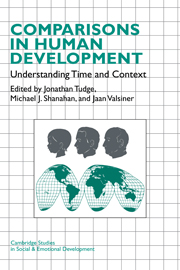Book contents
- Frontmatter
- Contents
- List of Contributors
- Comparisons in Human Development: To Begin a Conversation
- Part One Metatheoretical Approaches to Developmental Comparisons
- Part Two Paradigmatic Statements
- Part Three Comparisons at the Level of Data
- Part Four Commentaries
- 10 Developmental Science: A Case of the Bird Flapping Its Wings or the Wings Flapping the Bird?
- 11 Conceptual Transposition, Parallelism, and Interdisciplinary Communication
- 12 The “Ecological” Approach: When Labels Suggest Similarities beyond Shared Basic Concepts in Psychology
- 13 Problems of Comparison: Methodology, the Art of Storytelling, and Implicit Models
- 14 The Promise of Comparative, Longitudinal Research for Studies of Productive-Reproductive Processes in Children's Lives
- 15 Integrating Psychology into Social Science
- Author Index
- Subject Index
11 - Conceptual Transposition, Parallelism, and Interdisciplinary Communication
Published online by Cambridge University Press: 04 May 2010
- Frontmatter
- Contents
- List of Contributors
- Comparisons in Human Development: To Begin a Conversation
- Part One Metatheoretical Approaches to Developmental Comparisons
- Part Two Paradigmatic Statements
- Part Three Comparisons at the Level of Data
- Part Four Commentaries
- 10 Developmental Science: A Case of the Bird Flapping Its Wings or the Wings Flapping the Bird?
- 11 Conceptual Transposition, Parallelism, and Interdisciplinary Communication
- 12 The “Ecological” Approach: When Labels Suggest Similarities beyond Shared Basic Concepts in Psychology
- 13 Problems of Comparison: Methodology, the Art of Storytelling, and Implicit Models
- 14 The Promise of Comparative, Longitudinal Research for Studies of Productive-Reproductive Processes in Children's Lives
- 15 Integrating Psychology into Social Science
- Author Index
- Subject Index
Summary
In Chapter 2, Michael Shanahan, Jaan Valsiner, and Gilbert Gottlieb address the usefulness of common concepts for describing human development and discuss their transposition across psychobiology, psychology, and sociology. The concepts are identified as theoretical principles of human development that arise out of “an epigenetic characterization of development as an emergent coactional hierarchical system” (Gottleib 1991a, p. 7). We interpret their statements as proposing that development should be viewed in terms of a systemic structure with bidirectional relationships between vertical and horizontal levels, occurring in social and personal time, and changing probabilistically, where changes are manifested in coactional coordinated patterns across levels of human functioning. Further, we see their final principle as a different kind of statement, not defining development as such, but rather identifying developmentalists' studies of change as activities located within a disciplinary domain and influenced by intellectual and social criteria.
Shanahan et al. are interested in establishing a foundation for interdisciplinary communication and multidisciplinary research in developmental science. Their analysis of the across–discipline parallelism and transposability of developmentally significant concepts is a timely piece of metatheoretical research. Wielding the analytic tool of examining the underlying structure of theories, the authors demonstrate that the developmental principles can be employed as heuristic definitions to identify commonalities of use in the three disciplines.
- Type
- Chapter
- Information
- Comparisons in Human DevelopmentUnderstanding Time and Context, pp. 293 - 303Publisher: Cambridge University PressPrint publication year: 1996



